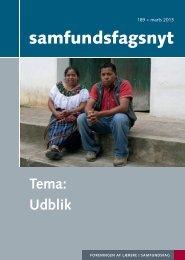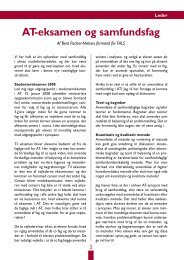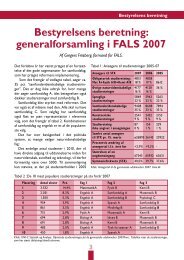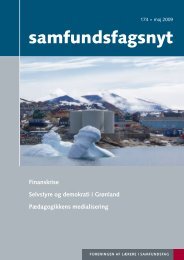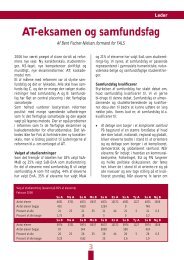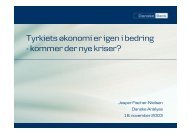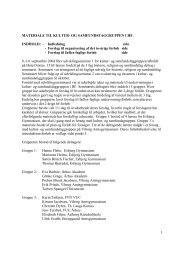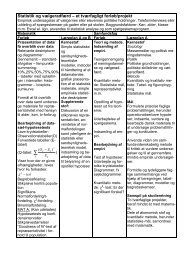Samfundsfagsnyt 160 - FALS
Samfundsfagsnyt 160 - FALS
Samfundsfagsnyt 160 - FALS
Erfolgreiche ePaper selbst erstellen
Machen Sie aus Ihren PDF Publikationen ein blätterbares Flipbook mit unserer einzigartigen Google optimierten e-Paper Software.
and pains, who oscillates like a homogeneous<br />
globule of desire of happiness under the<br />
impulse of stimuli that shift him about the<br />
area, but leave him intact. He has neither<br />
antecedent nor consequent. He is an isolated<br />
definitive human datum … 9<br />
With this construct at its centre, the dream of a<br />
determinate model of the economic universe<br />
was realised in the 1870s by William Stanley<br />
Jevons and, especially, by Léon Walras, both of<br />
whom were in part physicists by training: it was<br />
called the model of general equilibrium.And this<br />
elaborate mechanistic metaphor, proudly devoid<br />
of empirical content, remains today the grand<br />
narrative of economic theory, for students and<br />
economists everywhere.<br />
The model, which invariably is expressed in language<br />
so metaphorical that it would make a good<br />
poet blush, works by laying down a priori, like<br />
Euclidean geometry, a set of axioms:<br />
• The economic universe is determinate.<br />
• It exists in a void rather than in an ecosystem.<br />
• All relations in an economy are self-regulating, in<br />
the sense that any disturbance ‘sets in motion forces<br />
tending to restore the balance’.<br />
• These ‘forces’ result exclusively from the behaviour<br />
of isolated individual agents.<br />
• The behaviour of these agents conforms to certain<br />
mathematical properties. For example, consumer<br />
choice is characterised by transitivity (if X is preferred<br />
to Y and Y to Z, then X is always preferred to<br />
Z), completeness (out of the set of all possible<br />
bundles of goods, given a consumer’s income, she<br />
will consider her preference between every pair of<br />
them) and independence (consumers are not influenced<br />
by the choices of other consumers).<br />
To their credit, few economists have tried to<br />
provide empirical support for these axioms. Instead<br />
this is a realm in which formalistic expediency<br />
rules.The entities of the model, and the relations<br />
between them, must be conceived in a way<br />
that makes them isomorphic to those of Newton’s<br />
model of the physical universe.The exigencies<br />
of the grand metaphor rule even when the<br />
ARTIKEL - Når matematikken går ind<br />
27<br />
model is - as in the pedagogically popular Marshallian<br />
tradition - applied piecemeal and nonmathematically<br />
to individual markets.An example<br />
of such formalism is the elementary and ubiquitous<br />
notion of market demand for a product.<br />
Because a macro mass is in fact an additive function<br />
of its micro masses, neoclassical economics<br />
defines market demand as the additive function of<br />
the demands for product X of individual agents.<br />
But this assumes that everyone’s demand for a<br />
product is independent of everyone else’s<br />
demand for that product; for example, that one’s<br />
choice of a disco is not influenced by whether it<br />
is crowded or dead empty. Without such an<br />
assumption of independence (that is, the absence<br />
of all intersubjective effects) market demand as<br />
understood by mainstream economics does not<br />
exist. But as everyone knows - even neoclassical<br />
economists when they are off-duty - in consumer<br />
societies strong intersubjective effects in<br />
markets are the rule rather than the exception.<br />
However, in spite of such obvious and widespread<br />
empirically observable difficulties, the metaphors<br />
of neoclassicalism have remained dominant……..<br />
10<br />
I PAE-artikel efter artikel drøftes mange forskellige<br />
alternative tilgange til økonomiske problemer<br />
og for samfundsfagslæreren er der godt stof, der<br />
kan formidles i sammenhæng med de mange konkrete<br />
forsøg på fx at forstå velfærdsstatens<br />
udvikling, arbejdsmarkedet eller miljøproblemer.<br />
Så bliv fast netabonnent på PAE- det er gratis.<br />
Edward Fullbrook har i forlængelse af PAE redigeret<br />
en tekstsamling: A Guide to What’s wrong with Economics<br />
11 , der dækker forskellige kritikpunkter af<br />
mainstream-økonomien. Mikro og makro nonsens<br />
er fx en overskrift. Der er også artikler om brug<br />
og misbrug af matematik i økonomiske modeller.<br />
Bogens argumentation er opdelt i små artikler,<br />
som kan læses uafhængigt af hinanden og som er<br />
skrevet af økonomer knyttet til tidsskriftet.<br />
En anden kritisk økonom er australieren Steve<br />
Keen, der også er knyttet til tidsskriftet. Han har<br />
skrevet en meget morsom og kritisk fremstilling:<br />
Debunking Economics. The Naked Emperor of the<br />
Social Sciences 12 .



